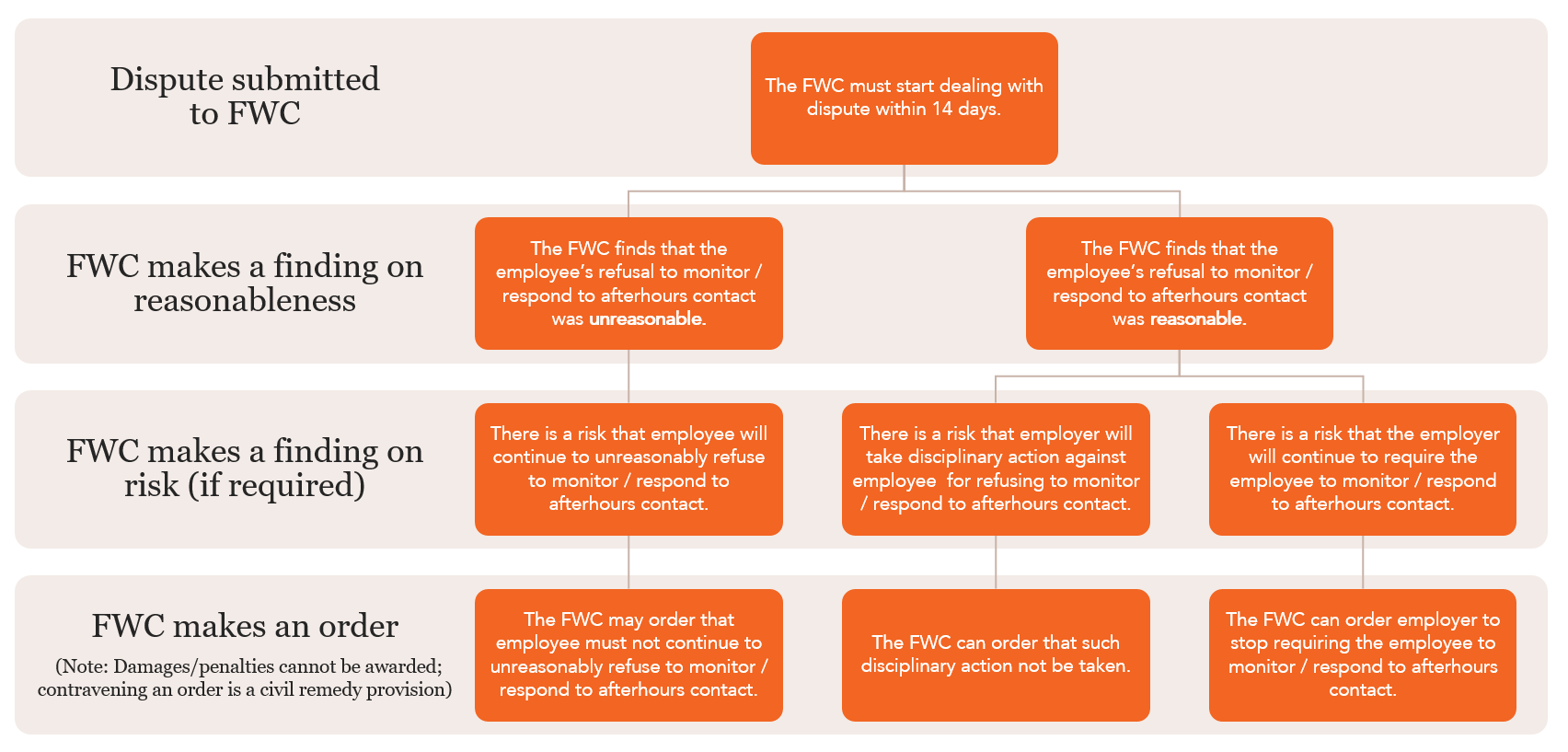Significant changes have come into effect with the commencement of the 'right to disconnect' legislation, a transformative shift in rights aimed at addressing the growing concerns of work-life balance. This legislation grants employees the legal right to disengage from work-related communications and tasks outside of their working hours without facing any negative consequences. As remote work and flexible hours become more prevalent, this move is seen as a crucial step towards ensuring that employees can completely unplug, aiming to foster a healthier, more sustainable approach to work. For an overview of the 'right to disconnect' view our article here.
In this article we will discuss the practical considerations of these changes, and the Fair Work Commissions' process for resolving disputes.
Implementing the Right to Disconnect
1. Review any relevant modern award clauses
The Fair Work Commission has now varied all modern awards to include a ‘Employee right to disconnect’ clause. It is important for employers to review the clauses relevant to their employees as they may have information specific to their industry/occupation – particularly in relation to on-call, recall, stand-by or emergency roster changes.
2. Review positions and consult with your employees
Through consultation with your employees, you can establish what the current practices are in the business. This may assist you to determine necessary and unnecessary afterhours contact. The right to disconnect can be seen as a psychosocial health and safety issue, which under the Work Health and Safety Act 2011 and the Managing the risk of psychosocial hazards at work Code of Practice 2022 requires employee consultation (see our article: A step by step guide to effective employee consultation).
In conducting this review, you should also consider provisions in employees’ current contracts and position descriptions. What do they say about how available the employee will make themselves? It may be necessary to seek legal advice to amend those provisions to specify any expectations/requirements for afterhours availability, and if necessary, include a reference to any policy (see below). Employees’ remuneration levels should also be reviewed to ensure they are adequately compensated for being required to be contactable afterhours. Award provisions should also be considered for overtime that could be triggered as a result of afterhours contact for example.
3. Establish a right to disconnect policy
Through consultation with employees, employers could develop a policy that deals with the right to disconnect and sets out for example, which roles are required to monitor, read, and respond to afterhours contact in relation to certain issues. This arguably will make it clear to the workforce who can reasonably be contacted after hours, and detail the usual arrangements for making contact as required by the model modern award clause for employees covered by an award.
We recommend that any policy should:
- make it clear that afterhours contact is generally discouraged unless reasonably necessary;
- provide guidance about reasonable out of hours contact (by email, text or phone);
- set out the relevant pay arrangements if an employee is required to monitor and respond to afterhours contact (where additional pay is necessary for making themselves available – e.g. in accordance with the terms of a modern award); and
- provide an avenue for raising concerns.
Our Workplace and Employment team are available to assist in drafting or reviewing any policy to support this new right.
4. Alert managers and leaders to the changes
Managers should receive training on this new ‘right’, including on:
- how to identify when afterhours contact is reasonable; and
- any particular pay arrangements/procedures in place for certain employees, particularly employees covered by a modern award.
They should also be encouraged to have discussions with their team members to identify when contact may reasonably be made, and to encourage employees to raise any concerns with them.
Those in leadership positions should lead by example, and not send emails out of hours unless necessary, or contemplated under the employer’s policy.
5. Consider whether technology can assist
Technology may assist with regulating afterhours contact – for example, a business may:
- install software so that all employees are aware of when the employee whom they are contacting is next scheduled to work;
- set up the email system so that emails sent afterhours are readily identifiable as urgent (i.e. requiring a response afterhours);
- encourage employees to use the ‘delay delivery’ option for emails – so that the recipient receives the emails on a day, or at a time, when they are next rostered to work;
- update their standard email footers to include a note reinforcing the business’ commitment to the right to disconnect; and
- send out-of-office messages to third parties, or notify third parties of to whom they should direct urgent communications.
6. Stay alert for upcoming Fair Work Commission Guidelines
The Fair Work Commission will publish guidelines in relation to the right to disconnect under the FW Act. The Fair Work Commission has indicated that it will publish guidelines once some cases have been heard.
If you require further information or assistance concerning these changes, particularly in consultation, drafting policies and amending template contracts, please contact our Workplace and Employment team.
Dispute resolution process
Disputes regarding whether the employer or employee have acted reasonably in relation to the right to disconnect are to be dealt with by the Fair Work Commission, and an order can be applied for by either an employee or an employer.
The Fair Work Commission’s process of dealing with a dispute is set out below:

If an application is made to the Fair Work Commission for an order, the Commission may deal with the dispute however it considers appropriate, including by mediation, conciliation, making a recommendation, expressing an opinion, or arbitration. We expect in most instances, a dispute will initially be dealt with (and most often resolved) by conciliation.
Potential legal actions
The dispute resolution process outlined above is the main legal remedy for an employee who is concerned about their right to disconnect. Breaching an order of the FWC will be a civil remedy provision.
The right to disconnect is also a workplace right under the FW Act. Employers must therefore not take adverse action (detrimental action) against an employee for exercising that ‘right’ under the general protections provisions of the FW Act.
Breaching the general protections provisions or modern awards can result in damages and civil penalties, currently up to $18,780 per contravention for an individual involved in a contravention, $93,900 per contravention for a company with less than 15 employees, and $469,500 per contravention for a company with 15 or more employees. Therefore, if an employee refuses to respond to afterhours contact, and an employer considers this unreasonable, the employer should consider (and seek legal advice on) whether it is better to engage with the dispute resolution process under the FW Act (outlined above) before considering any disciplinary action.
The right to disconnect has already been considered in a recent workers’ compensation matter. In Brennan v BWP [2024] NSWPIC 165, the Tribunal Member criticised an employer for continued attempts to contact an employee when they were on short term sick leave, stating this was not reasonable action by the employer, and noting the proposed right to disconnect.


